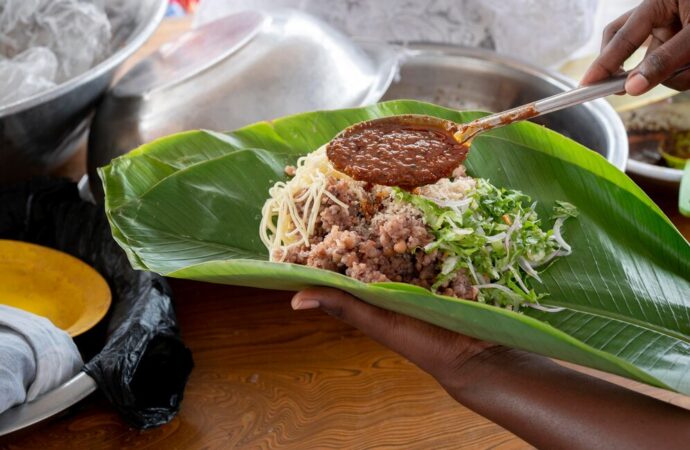You’ve probably noticed people dining on the wide, lush leaf of the banana plant. These expansive, smooth, and shiny leaves are often used to enclose food during cooking. They also serve as natural dining mats or eco-friendly plates. Due to their bold color and impressive size, banana leaves are frequently featured in cultural celebrations and
You’ve probably noticed people dining on the wide, lush leaf of the banana plant. These expansive, smooth, and shiny leaves are often used to enclose food during cooking. They also serve as natural dining mats or eco-friendly plates. Due to their bold color and impressive size, banana leaves are frequently featured in cultural celebrations and traditional decorations. Since they decompose naturally, they’re a sustainable choice compared to plastic alternatives. Their versatility makes them valuable not only in the kitchen and for food presentation but also in various beauty practices.
What is a Banana leaf?
Have you ever been curious about the leaf often used as a plate in South Indian meals? That’s known as a banana leaf! This vibrant green leaf originates from the banana plant and is recognized for its wide, flat, and elongated shape. It’s notably large, ranging from about 12 to 20 inches in width and reaching up to 3 feet in length. Banana leaves are flexible, water-resistant, and cylindrical in form. Due to their spreading and extended structure, they serve many purposes. Across India, they are referred to by various local names depending on the region.
Cultural Importance of Using Banana Leaf
Beyond adding a subtle aroma to dishes and serving as a sustainable substitute for plastic, the banana leaf holds deep-rooted cultural value. It plays an essential role in traditional feasts, rituals, and daily meals. Let’s explore its significance:
- It represents purity and good fortune. The banana leaf is often used in religious rituals and festive occasions.
- It symbolizes a connection with nature and promotes an eco-conscious way of living that aligns with cultural traditions.
- In many regions of India, meals served on banana leaves encourage communal eating, reinforcing bonds and a sense of unity.
- As a compostable and earth-friendly option, it reflects centuries-old practices of mindful living and respect for the environment.
9 Health Benefits of Eating on a Banana Leaf
Banana leaves aren’t just traditional or decorative; they also offer several health-related advantages when used in food preparation and serving. Here are the top benefits of eating on a banana leaf:
Rich in Fiber
When food, especially rice-based meals, is served on banana leaves, it can help increase your fiber intake. Fiber supports heart health and aids in digestion and energy regulation. The more thoughtfully you prepare meals using banana leaves, the more you can tap into these natural benefits.
Natural Antioxidant Properties
Banana leaves contain polyphenols, natural antioxidants that can help the body fight off free radicals and reduce the risk of chronic illnesses. Serving hot food on the leaf can transfer a small amount of antioxidants to the meal. This is one reason banana leaves remain a preferred choice in traditional cooking.
A Balanced Meal Platform
Using banana leaves to serve rice, pickles, meats, and vegetables brings everything together into a complete, balanced meal. It’s visually appealing and encourages a nutritious and varied diet. With their natural appeal and functional use, banana leaves support healthier eating in an eco-friendly way.
Low in Fat
Banana leaves themselves contain virtually no fat, making them an excellent option for health-conscious cooking. While oils like coconut or vegetable oil may be added to recipes served on the leaf, the leaf itself does not contribute to the fat content. The resulting meal is often well-balanced and nutritious when paired with coconut milk and vegetables.
Gluten-Free
Since banana leaves are naturally gluten-free, they make a great choice for those with gluten sensitivities or celiac disease. Serving food on these leaves helps ensure no cross-contamination from wheat-based products, supporting a safer and more inclusive dining experience.
Aids in Digestion
Thanks to their natural fiber content and antibacterial properties, banana leaves can promote better digestion. They help keep your digestive system functioning efficiently and may even soothe the stomach. When used regularly, banana leaves can support digestive health without any harmful side effects.
Keep Hydrate
One of the unique qualities of banana leaves is their ability to retain moisture. This not only helps keep food fresh and hydrated but may also promote better hydration in the body when used regularly in meal preparation. It’s a culturally rooted practice that reflects a natural approach to nourishment.
Naturally Biodegradable
Unlike plastic or paper products that require time and effort to decompose, banana leaves break down naturally in the environment. They require no special processing and return to the earth within days, making them a highly sustainable alternative. Their ease of disposal and zero environmental impact make them ideal for eco-conscious lifestyles.
Enhances Food Flavour
When hot dishes like rice are served on banana leaves, the heat releases the leaf’s natural scent, infusing the food with a subtle, pleasant aroma. This gentle fragrance adds a unique layer of flavor, making even simple meals more inviting and flavorful. The freshness of the leaf complements the dish, enhancing both its scent and taste.



















Leave a Comment
Your email address will not be published. Required fields are marked with *